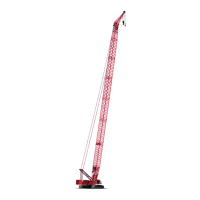INTRODUCTION 16000 SERVICE/MAINTENANCE MANUAL
1-60
Published 05-03-17, Control # 228-03
Jacking Cylinders
See Figure 1-49 and Figure 1-50.
There is one jacking cylinder on each corner of the
counterweight base. The jacking cylinders are for raising the
counterweight wheels off the ground to allow the wheeled
counterweight assembly to stand by itself when not attached
to the crane, wheel positioning, or to aid in tire maintenance.
Struts must be pinned to each jack cylinder to stabilize the
counterweight assembly when it is not attached to the crane.
Each jacking cylinder has a counterbalance valve at each
cylinder port to provide smooth operation when operating.
The counterbalance valves lock the cylinder in position and
provide the cylinder with relief protection. The jacking three
position spool valves are motor spooled where both cylinder
ports and the tank port of the valve spool section are
connected in the center position.
Each jacking cylinder has an end of travel sensor that stops
the jacking cylinder travel at a preset position and sends an
input voltage signal to the Node-1 controller. Each jacking
cylinder end of travel sensor is normally open. All jack end of
travel switches must be closed before the wheeled
counterweight assembly can travel or swing.
The MAX-ER base level sensor indicates the counterweight
base roll and pitch to ± 4.5° from zero and sends an input
voltage to the Node-1 controller.
Power is available to the hand-held wireless remote control
when, the engine is running, the MAX-ER function mode is
selected, and the power button is pressed. The jacking
cylinders cannot be extended/retracted until the electrical
cables and hydraulic lines are connected between the rear of
the crane and the telescopic beam of the wheeled
counterweight assembly.
When operating, the left travel handle can control the
operation of the jacking cylinders when travel is parked and a
MAX-ER chart is selected. Moving the left travel handle
forward enables all the jacking cylinders down. Moving the
left travel handle back enables all the jacking cylinders up.
The left travel jacking cylinder extend/retract is similar to the
hand-held wireless remote control operation described next.
Extend Jacking Cylinders
When selected the jack or jack all switch is moved and held
in the extend position, an input signal from the wireless
transmitter is sent to a receiver on the crane. The receiver
sends the input signal to the Node-1 controller. Node-7
sends a 24 volt output to enable the selected jack cylinder
solenoid (HS-74 in this example) and shifts the valve to the
extend position.
The Node-3 controller also sends a variable 0 to 24 voltage
to enable the proportional relief solenoid HS-68 to provide
approximately 310 bar (4,496 psi) pressure to the jack
system.
Hydraulic pressure from the accessory pump flows through
the pressure control pilot valve, the six bank manifold valve,
and enters the free-flow check valve section of the
counterbalance valve. Fluid pressure on the piston end of
selected jack cylinder extends the jack cylinder to raise the
wheeled counterweight base.
Hydraulic fluid from the rod end of jack cylinder is blocked by
the free-flow check valve section of the counterbalance valve
and the flow restraining section of the relief valve preset for a
relief setting of approximately 138 bar (2,002 psi). The rod
end cylinder pressure opens the restraining section of the
counterbalance valve, allowing fluid to exit the valve. Return
hydraulic fluid passes through the six bank manifold valve
before returning to the crane hydraulic tank through a return
line.
When the desired jack cylinder extension is reached, release
the selected jack switch to lock the jack cylinder(s) in
position. Hydraulic fluid at the piston end of the jack cylinder
counterbalance valve supports the weight and the gravity
force of the wheeled counterweight assembly.
When the selected jack switch is released, an input signal is
sent to the Node-1 controller. The Node-7 controller sends a
zero volt output to the hydraulic solenoid HS-74 to the return
valve to the center position.
Node-3 sends a variable voltage output to the accessory
system proportional relief solenoid HS-68 to provide
approximately 28 bar (406 psi) system pressure.
Retract Jacking Cylinders
When the selected jack or jack all switch is moved and held
in the retract position, an input signal from the wireless
transmitter is sent to a receiver on the crane. The receiver
sends the input signal to the Node-1 controller. Node-7
DANGER
Tipping Hazard!
Wheeled counterweight assembly can tip:
• Extend and retract jacking cylinders slowly to keep
counterweight base as level as possible.
• Do not extend jacking cylinders if wheeled
counterweight assembly is not attached to the crane
and wheels are not at stand alone position.
• Make sure struts are pinned to the jacking cylinders
when raising the base with the jacking cylinders.
• Read and understand the counterweight jack
procedure before operating the MAX-ER wireless
remote control.

